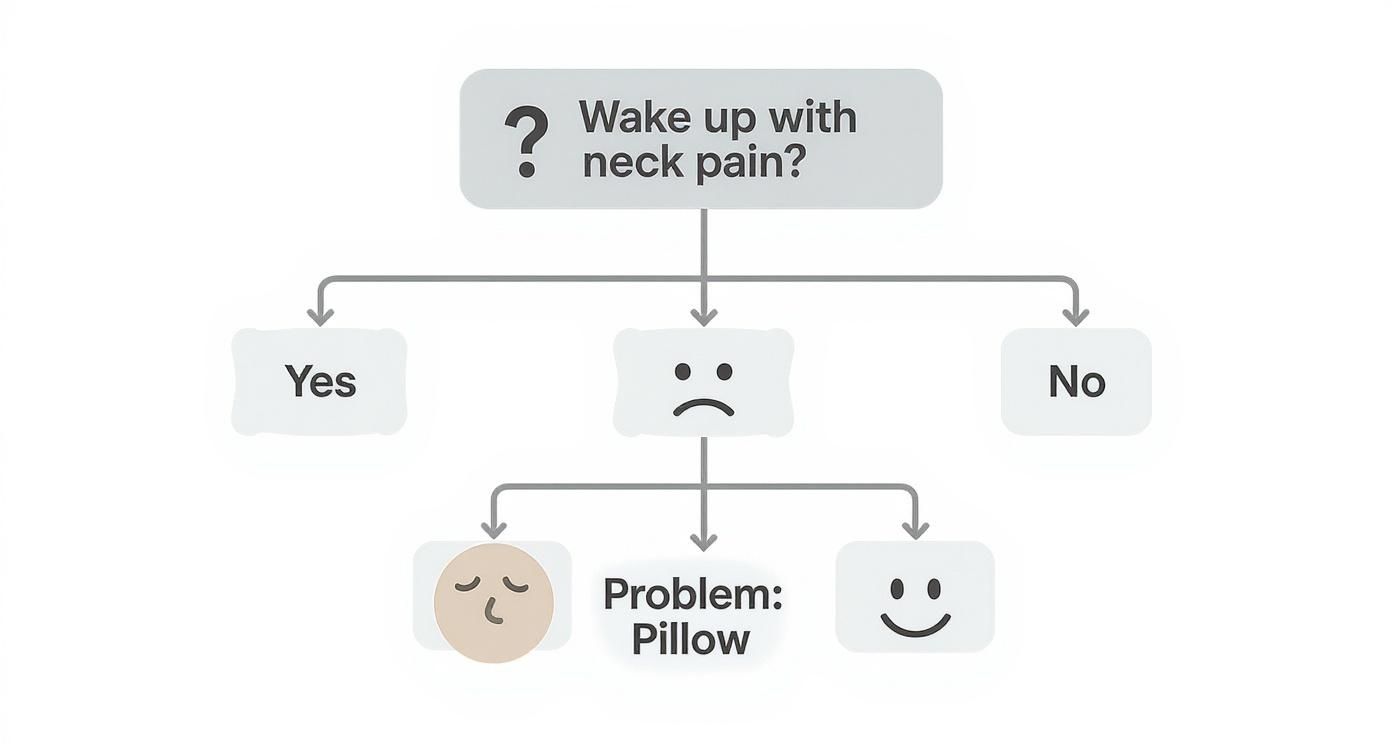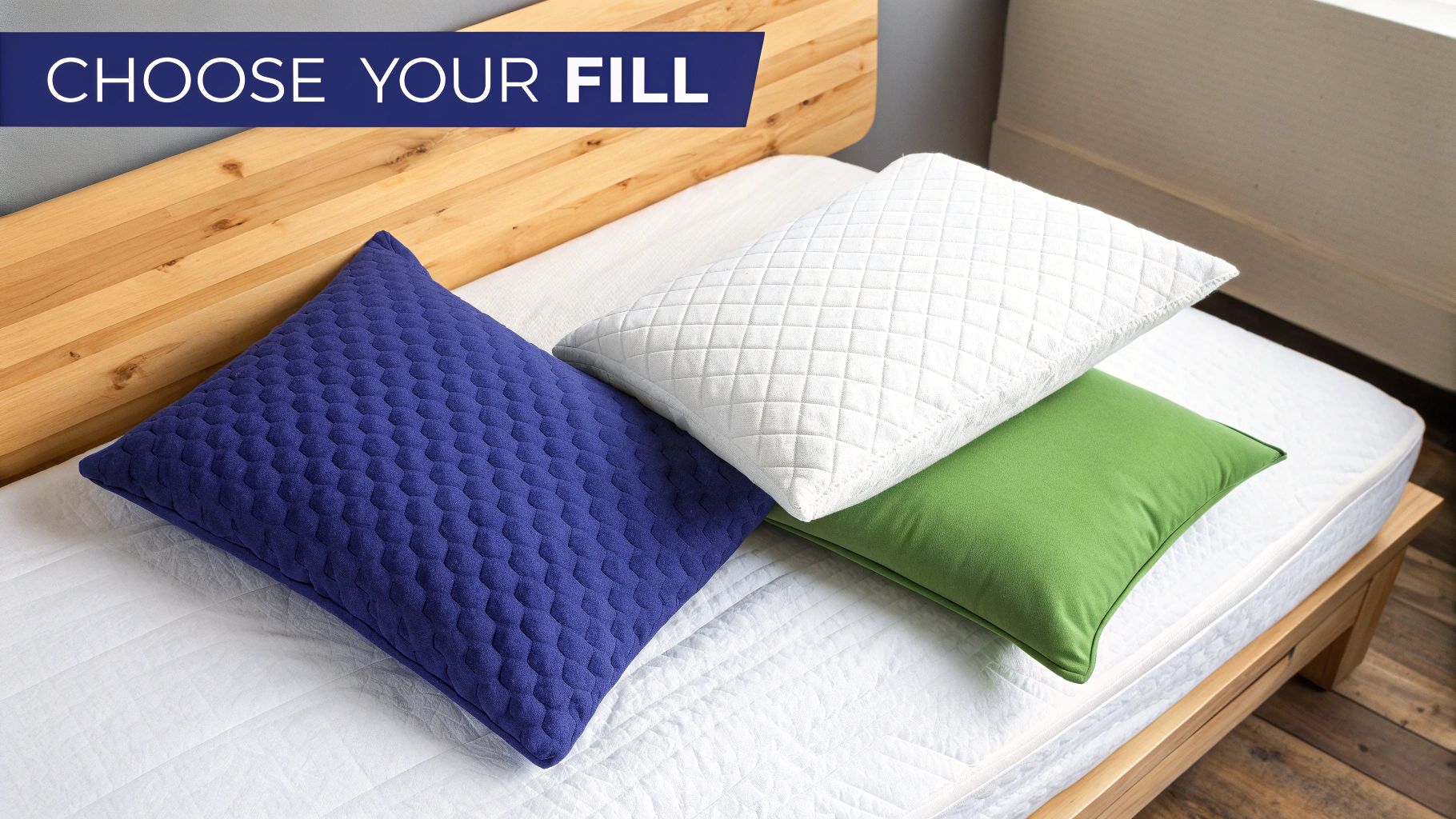Waking up with a stiff neck or achy shoulders is a frustratingly common story for side sleepers. And more often than not, the culprit is hiding in plain sight: your pillow. If it’s not properly filling that crucial gap between your head and the mattress, it's forcing your spine out of alignment all night long.
The best pillow for side sleepers boils down to two simple but essential things: the right height (loft) and firm support to keep your head, neck, and spine in a perfectly straight line.
Why Your Pillow Is Wrecking Your Sleep
Still waking up feeling like you’ve gone a few rounds in a boxing ring? It’s time to point the finger at your pillow. A huge 60-70% of us sleep on our sides, and this position creates a unique challenge—that space between your ear and the outer edge of your shoulder needs to be completely supported.
When your pillow is too soft or thin, your head sinks down, putting a serious strain on your neck muscles. It’s a guaranteed recipe for discomfort.
On the other hand, a pillow that’s too thick or high forces your head upwards at an awkward angle, which causes the exact same kind of strain. This constant misalignment is a direct cause of:
- That all-too-familiar morning neck and shoulder pain.
- Nagging tension headaches.
- Tossing and turning all night trying to find a comfortable spot.
The whole point is to achieve a ‘neutral spine,’ where your head isn't tilting up, down, or sideways. Proper alignment lets your muscles finally relax, paving the way for deeper, more restorative sleep. For more tips on improving your overall rest, check out these strategies on how to sleep better at night.
Kiwis are Catching On
More and more, New Zealanders are connecting the dots between quality sleep and overall health. While we don't have exact stats on pillow preferences, market trends tell a clear story: we're investing in better bedding.
In fact, New Zealand’s bedding market is forecast to hit NZ$122.72 million in revenue in 2025. With side sleepers making up the majority of the population, a huge chunk of that spending will be on finding the perfect pillow. You can explore more about NZ bedding market trends on Statista.com.
A supportive pillow isn't a luxury—it's an essential tool for healthy sleep posture and preventing pain. Getting it right is a direct investment in how you feel every single day.
This guide will walk you through exactly how to choose the right pillow, so you can finally get the pain-free rest you’ve been missing. You can also learn more by understanding and enhancing sleep quality in New Zealand in our comprehensive article.
Finding The Right Pillow Height And Firmness
When you’re picking the perfect pillow for side sleeping, two words matter more than any others: loft and firmness. Simply put, loft is how high or thick a pillow is, and firmness is how much it pushes back when you lay your head on it. Nailing these two is the secret to a great night's sleep and waking up without that all-too-familiar neck ache.
Think of it this way: your pillow’s entire job is to perfectly fill the space between your head and the mattress, keeping your spine in a nice, straight line from your neck down to your tailbone. If you've got broad shoulders, you have a bigger gap to fill. Someone with a smaller frame, on the other hand, needs less height.
A pillow that’s too high or too low throws everything out of alignment—and that's the number one cause of morning stiffness and pain.

As you can see, if you're waking up sore, there’s a very good chance your pillow is to blame.
How To Figure Out Your Ideal Loft
Want a quick way to estimate your perfect pillow height? Stand next to a wall, lean your shoulder against it like you're in your sleeping position, and measure the distance between your ear and the wall. This gives you a great starting point for the loft you need.
Generally, most side sleepers will find their sweet spot with a medium-to-high loft pillow, usually somewhere in the 12 to 18 centimetre range. But don't forget to factor in your mattress! If you have a plush, soft mattress that your shoulder sinks into, you'll need a slightly lower loft pillow to compensate. It's all about teamwork, which is why it helps to understand why mattress firmness matters in the first place.
To make things a bit easier, here’s a quick reference guide to help you match your body and bed to the right pillow.
Pillow Loft And Firmness Guide For Side Sleepers
| Shoulder Width | Mattress Type | Recommended Pillow Loft | Recommended Firmness |
|---|---|---|---|
| Narrow | Soft Mattress | 10-12 cm (Low-Medium) | Medium-Soft |
| Narrow | Firm Mattress | 12-14 cm (Medium) | Medium |
| Average | Soft Mattress | 12-14 cm (Medium) | Medium |
| Average | Firm Mattress | 14-16 cm (Medium-High) | Medium-Firm |
| Broad | Soft Mattress | 14-16 cm (Medium-High) | Medium-Firm |
| Broad | Firm Mattress | 16-18 cm (High) | Firm |
This table is a great starting point, but remember to trust how you feel. Your own comfort is the final judge.
Why Firmness Is So Important
Loft fills the gap, but firmness is what keeps your head properly supported all night long. A pillow that’s too soft might feel lovely for a few minutes, but it will quickly flatten under the weight of your head. Before you know it, your neck is at that awkward downward angle again.
This is why a medium to firm pillow is almost always the best choice for side sleepers.
A pillow with the right firmness doesn't just feel good—it actively supports your head and neck, maintaining proper spinal alignment so your muscles can finally relax and recover while you sleep.
It prevents your head from gradually sinking through the night, ensuring you get consistent support from bedtime until your alarm goes off. If you want to explore materials that really shine in this area, you can learn more about the best memory foam pillows for side sleepers, as they are often engineered to provide that perfect blend of contouring and support.
Picking the Right Pillow Material
Alright, you’ve got the loft and firmness sorted. Now for the fun part: deciding what your pillow is made of. The fill material is a huge deal for side sleepers, affecting everything from support and comfort to whether you wake up feeling too hot.
Every material has its own personality, so finding the one that suits you is key.

Memory foam is a crowd favourite for good reason. It’s brilliant at moulding to the exact shape of your head and neck, offering incredible, customised pressure relief. The only catch? Some traditional memory foams can trap body heat, which isn't ideal if you tend to sleep warm.
Then there's latex. It offers a completely different feel—much more responsive and almost springy. It still contours to your shape but bounces back immediately, making it much easier to shift positions during the night without feeling like you’re stuck in quicksand.
A Deeper Dive Into Pillow Fills
If you love that traditional, sink-in softness, down and feather pillows might seem tempting. They feel incredibly luxurious and are easy to shape. But for a side sleeper, that's also their biggest flaw. They tend to flatten out as the night goes on, meaning you’ll be constantly fluffing and reshaping them to get the consistent support your neck desperately needs.
Thankfully, pillow materials have come a long way. While we don't have hard numbers for New Zealand, global sleeping pillow market trends show that memory foam had the biggest market share in 2022. Here at home, you'll find most sleep experts point towards memory foam, latex, or hybrid pillows because they simply do a better job of keeping your spine aligned.
The perfect material balances that "ahhh" feeling of comfort with the non-negotiable support your body needs. A pillow that feels amazing but lets your head droop is just as bad as one that’s supportive but feels like a brick.
How to Choose Your Ideal Match
Think about what really matters to you in a pillow. Your personal preferences will point you in the right direction.
- Want top-tier contouring and pressure relief? Memory foam is your best bet.
- Need responsive support and a cooler sleep? Latex is a fantastic choice. Our Puro Latex Classic Pillow is a great example of a durable, hypoallergenic option.
- Crave a plush, cloud-like feel? A down or down-alternative could work, but just be ready for the daily fluffing routine to keep it from going flat.
Once you know what each material brings to the table, you can pick a pillow for side sleepers that doesn’t just feel incredible but also gives your spine the support it needs to keep you comfortable all night long.
Smart Shopping for Pillows in New Zealand
Finding the right pillow in New Zealand comes down to knowing what to look for, whether you’re browsing in person at Farmers and Briscoes or exploring the huge range online. A smart strategy is your best friend here.
Let's be honest, online shopping has completely changed how we buy bedding. Kiwi retailers and big online stores have an incredible selection, making it easy to compare pillows from your couch. This means you have access to far more options than you'd ever find in a physical store. For a deeper dive into this shift, you can discover insights about the global pillow market.
Decoding Product Descriptions and Reviews
When you're shopping online, the product description is your starting point. You need to look past the fancy marketing words and hunt for the hard facts, especially for a pillow for side sleepers.
Keep an eye out for these specifics:
- Loft measurement: Is the pillow's height clearly listed in centimetres?
- Firmness level: Do they describe it as medium, firm, or medium-firm?
- Material composition: What’s it actually made of? Memory foam, latex, a down alternative?
Customer reviews are pure gold, but you have to read them carefully. Skip the vague "Great pillow!" comments and search for detailed feedback from people who mention they are side sleepers. Did they wake up with less neck stiffness? Do they talk about how well the pillow has kept its shape after a few months?
The most valuable reviews come from people who have slept on the pillow for several weeks. Their experience gives you a far better idea of long-term performance than someone's first-night impression.
The Importance of Trial Periods and Returns
A pillow is a very personal purchase. What feels like a cloud to one person could be a rock to another, which is why a trial period or a solid return policy is a must-have.
Many reputable sellers, including our own range of pillows and bed sheets, understand this and offer sleep trials. It’s a crucial safety net that lets you test the pillow in your own bed to see if it genuinely supports your neck and spine, all without the risk of being stuck with something that doesn’t work. Just make sure you read the fine print before you buy.
Keeping Your Pillow in Top Shape
You’ve found the perfect pillow—now treat it like the sleep investment it is. A little TLC will go a long way in making sure it keeps giving you the support you need, night after night. Proper care not only extends its life but also keeps it fresh and hygienic, so your ideal pillow for side sleepers stays that way for as long as possible.

Before you do anything, the golden rule of pillow care is to always check the manufacturer's cleaning instructions. Different materials need different handling. For example, throwing a memory foam or latex pillow in the washing machine is a fast way to ruin it, so always check the care tag first.
Simple Habits for a Longer Pillow Life
A few small habits, done daily or weekly, can make a massive difference. These quick actions prevent the build-up of dirt and oils and help your pillow keep its shape.
- Use a Pillow Protector: This is non-negotiable. A quality, washable protector is your first line of defence against sweat, skin oils, and allergens, keeping the pillow itself much cleaner for much longer.
- Give it a Daily Fluff: Seriously, take 10 seconds each morning to plump up your pillow. This simple move helps to redistribute the filling, restores its loft, and stops it from developing those dreaded permanent flat spots.
Think of your pillow as a crucial piece of sleep equipment, not just a cushion. Looking after it properly means it can keep doing its job: supporting your spine for a restful, pain-free night.
Of course, no pillow lasts forever. It’s time for a replacement if you notice it's lumpy, has lost a lot of its height, or if you can fold it in half and it stays that way without springing back.
A Few More Questions We Often Hear
Even when you think you've found the one, a few questions always seem to crop up. Nailing these final details can be the difference between a decent sleep and a truly restorative one.
Let's tackle a couple of the most common queries we get from side sleepers.
"Should I really put a pillow between my knees?"
Yes, absolutely. This is one of the best habits a side sleeper can adopt.
Placing a firm pillow between your knees does something brilliant: it keeps your hips, pelvis, and spine in a neutral line. This stops your top leg from sliding forward and twisting your lower back into an unnatural position. It’s a simple trick, but it makes a huge difference in reducing hip and lower back strain overnight.
"What if I don't just sleep on my side?"
Ah, the classic combination sleeper. If you roll from your side to your back throughout the night, you need a pillow that can keep up.
This is where an adjustable pillow really shines. Think shredded memory foam or latex fills that you can shape and mould to fit your position perfectly. You can bunch it up for higher loft on your side, then flatten it out a bit when you roll onto your back. Some clever ergonomic pillows are even designed with different heights on each side for this exact reason.
Give it time. It can take up to a week for your body to adjust to a new, more supportive pillow. The true test is how you feel when you wake up. If you're consistently free of stiffness, you've found a winner. If your head feels pushed up or like it's dropping down, the loft isn't quite right.
For more answers to common sleep questions, have a look through our full FAQs page for some extra pointers.
Ready to find your perfect match? Explore the complete collection of supportive pillows at New Zealand Bed Company and invest in pain-free sleep tonight. https://nzbeds.co.nz

